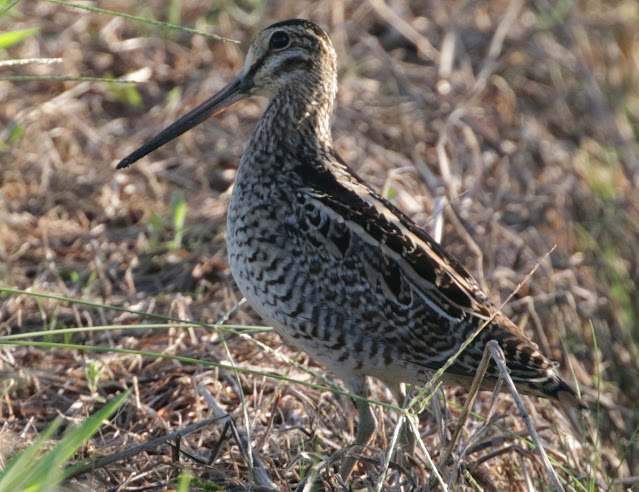This autumn has somehow got away from me on the wader front, it wasn't until last weekend I made my first trip across the Kii Peninsula to my favourite wader haunts in Mie. The first area of small fields I visited, about 500m x 300m in total, was in excellent wader condition so, apart from a couple of convenience store runs and three circuits of the good nearby sites, I ended up spending the whole day there. It's possible to drive miles without finding a suitable field so I considered myself lucky.
There were two or three Little as well as the two commoner stints, a couple of Broad-billed Sands which aren't that common round this way, as well as a number snipe. So plenty to keep me occupied especially as the latter are my favourite time drain.
I've no idea how many snipe there may have been on the patchwork of small fields, I focused on just one as far as the snipe were concerned. Or to be more precise, I focused on just one edge of one small field. The only Common Snipe I saw were the occasional disturbed birds that flew round overhead calling before settling back into the vegetation. There was even a calling swintail at one point that rose from no more than 20 metres away in my own small field when it was flushed by a family boisterously enjoying their Saturday morning walk around the fields.
There were usually three snipe along this edge, they never disappeared for long and I never saw more than three at any one time. I suspect that they really were the same three birds remaining loyal to the same spot. Presumably all the other snipe across the fields were doing exactly the same.
Even though a good view the outer rectrices is considered the only way to identify a swintail, there are a number of morphological 'tendencies' and generally speaking it's possible to have anything from an idea which species it is, to being willing to bet the house on which one you're viewing without seeing those pesky outer tail feathers. By 'tendencies' I mean features that one species exhibits more often than the other without being conclusive in itself. I said generally speaking because there are times when a bird which is looking a really good contender for one species will suddenly shock by revealing the wrong outer tail feathers.
Getting a good view of the incontovertible outer tail feathers can be easier said than done as Pintails' pins can remain tucked in when sunbathing and thus give the impression of not having any. Of course the sunbathing snipe may actually be a Swinhoe's (which seems far commoner than Pintail in this region) and you can spend no end of time trying to see non-existent pins. Bearing in mind that Swinhoe's and Pintail have about the same number of tail feathers if the pins are discounted, there isn't a noticeable difference in tail size or overall shape. Seeing the pins when a tail is flashed in some interaction is next to impossible so it really comes down to seeing a bird preening in the open at the right angle.
Last Saturday I saw one of the three birds preen twice, once in the open (though not at an ideal angle) early in the morning and again in the afternoon when largely hidden in the rice. I didn't see the other two birds preen at all and never got clear views of their outer tail feathers. Snipe really are a time drain.
 |
| Pintail in the foreground, then Latham's and finally swintail at the rear. They spent much of their feeding time probing into the side of the bund. |
 |
| Latham's with swintail behind. |
I'll start with images of the Pintail, the only bird that let me see its outer tail feathers clearly.
 |
| This bird was easily separated from the other dark juvenile its heavy barring extending well down the flanks. |
 |
 |
 |
 |
| One of only two shots I was able to get that gave any indication of pins. |






















